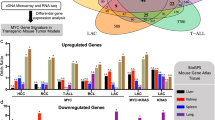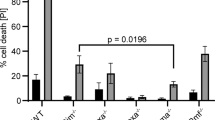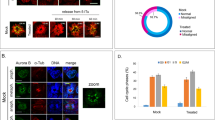Abstract
The Friend-virus-derived1 mouse erythroleukaemia (MEL) cell lines represent transformed early erythroid precursors that can be induced to differentiate into more mature erythroid cells by a variety of agents including dimethyl sulphoxide (DMSO)2There is a latent period of 12 hours after inducer is added, when 80–90% of the cells become irreversibly committed to the differentiation programme, undergoing several rounds of cell division before permanently ceasing to replicate3,4. After DMSO induction, a biphasic decline in steady-state levels of c-myc5,6 and c-myb6 messenger RNAs occurs. Following the initial decrease in c-myc mRNA expression, the subsequent increase occurs in, and is restricted to, the Gl phase of the cell cycle7. We sought to determine whether the down-regulation is a necessary step in chemically induced differentiation. Experiments reported here indicate that expression in MEL cells of a transf ected human c-myc gene inhibits the terminal differentiation process.
This is a preview of subscription content, access via your institution
Access options
Subscribe to this journal
Receive 51 print issues and online access
$199.00 per year
only $3.90 per issue
Buy this article
- Purchase on Springer Link
- Instant access to full article PDF
Prices may be subject to local taxes which are calculated during checkout
Similar content being viewed by others
References
Friend, C., Scher, W., Holland, J. G. & Sato, T. Proc. natn. Acad. Sci. U.S.A. 68, 378–382 (1971).
Marks, P. A. & Rifkind, R. A. A. Rev. Biochem. 47, 419–448 (1978).
Fibach, E., Reuben, R. C., Rifkind, R. A. & Marks, P. A. Cancer Res. 37, 440–444 (1977).
Gusella, J., Geller, R., Clarke, B., Weeks, V. & Housman, D. Cell 9, 221–229 (1976).
Lachman, H. M. & Skoultchi, A. I. Nature 310, 592–594 (1984).
Kirsch, I. R., Bertness, V., Silver, J. & Hollis, G. F. J. cell. Biochem. (in the press).
Lachman, H. M., Hatton, K. S., Skoultchi, A. I. & Schildkraut, C. L. Proc. natn. Acad. Sci. U.S.A. 82, 5323–5327 (1985).
Charnay, P. et al. Cell 38, 251–263 (1984).
Yang, J. Q. et al. Curr. Topics Microbiol. Immun. 113, 146–153 (1984).
Dmitrovsky, E. et al. Curr. Topics Microbiol. Immun. (in the press).
Falcone, G., Tato, F. & Alema, S. Proc. natn. Acad. Sci U.S.A. 82, 426–430 (1985).
Coppola, J. A. & Cole, M. D. Nature 320, 760–763 (1986).
Westin, E. H. et al. Proc. natn. Acad. Sci. U.S.A. 79, 2490–2494 (1982).
Gonda, T. J. & Metcalf, D. Nature 310, 249–251 (1984).
Campisi, J., Gray, H. E., Pardee, A. B., Dean, M. & Sonenshein, G. E. Cell 36, 241–247 (1984).
Davis, L., Dibner, M. & Battey, J. Methods in Molecular Biology (Elsevier, Amsterdam, 1986).
Graham, F. L. & Van der Eb, A. J. Virology 52, 456–467 (1973).
Lau, Y.-F. & Kan, Y. W. Proc. natn. Acad. Sci U.S.A. 80, 5225–5229 (1983).
Chirgwin, J. M., Przybyla, A. E., MacDonald, R. J. & Rutter, W. J. Biochemistry 18, 5294–5299 (1979).
Southern, E. M. J. molec. Biol. 98, 503–517 (1975).
Bender, T. P. & Kuehl, W. M. Proc. natn. Acad. Sci. U.S.A. 83, 3204–3208 (1986).
Battey, J. et al. Cell 34, 779–787 (1983).
Author information
Authors and Affiliations
Rights and permissions
About this article
Cite this article
Dmitrovsky, E., Kuehl, W., Hollis, G. et al. Expression of a transfected human c-myconcogene inhibits differentiation of a mouse erythroleukaemia cell line. Nature 322, 748–750 (1986). https://doi.org/10.1038/322748a0
Received:
Accepted:
Issue Date:
DOI: https://doi.org/10.1038/322748a0
This article is cited by
-
MYC: a multipurpose oncogene with prognostic and therapeutic implications in blood malignancies
Journal of Hematology & Oncology (2021)
-
Fbw7-dependent cyclin E regulation ensures terminal maturation of bone marrow erythroid cells by restraining oxidative metabolism
Oncogene (2014)
-
MYC oncogene in myeloid neoplasias
Clinical and Translational Oncology (2013)
-
Long-term cultivation of in vitro Apis mellifera cells by gene transfer of human c-myc proto-oncogene
In Vitro Cellular & Developmental Biology - Animal (2011)
-
Reflecting on 25 years with MYC
Nature Reviews Cancer (2008)
Comments
By submitting a comment you agree to abide by our Terms and Community Guidelines. If you find something abusive or that does not comply with our terms or guidelines please flag it as inappropriate.



